Proton sensitivity of rat cerebellar granule cell GABAA receptors: dependence on neuronal development
- PMID: 11208970
- PMCID: PMC2278406
- DOI: 10.1111/j.1469-7793.2001.0219l.x
Proton sensitivity of rat cerebellar granule cell GABAA receptors: dependence on neuronal development
Abstract
The effect of GABAA receptor development in culture on the modulation of GABA-induced currents by external H+ was examined in cerebellar granule cells using whole-cell and single-channel recording. Equilibrium concentration-response curves revealed a lower potency for GABA between 11 and 12 days in vitro (DIV) resulting in a shift of the EC50 from 10.7 to 2.4 uM. For granule cells before 11 DIV, the peak GABA-activated current was inhibited at low external pH and enhanced at high pH with a pKa of 6.6. For the steady-state response, low pH was inhibitory with a pKa of 5.56. After 11 DIV, the peak GABA-activated current was largely pH insensitive; however, the steady-state current was potentiated at low pH with a pKa of 6.84. Single GABA-activated ion channels were recorded from outside-out patches of granule cell bodies. At pH 5.4-9.4, single GABA channels exhibited multiple conductance states occurring at 22-26, 16-17 and 12-14 pS. The conductance levels were not significantly altered over the time period of study, nor by changing the external H+ concentration. Two exponential functions were required to fit the open-time frequency histograms at both early (< 11 DIV) and late (> 11 DIV) development times at each H+ concentration. The short and long open time constants were unaffected either by the extracellular H+ concentration or by neuronal development. The distribution of all shut times was fitted by the sum of three exponentials designated as short, intermediate and long. At acidic pH, the long shut time constant decreased with development as did the relative contribution of these components to the overall distribution. This was concurrent with an increase in the mean probability of channel opening. In conclusion, this study demonstrates in cerebellar granule cells that external pH can either reduce, have no effect on, or enhance GABA-activated responses depending on the stage of development, possibly related to the subunit composition of the GABAA receptors. The mode of interaction of H+ at the single-channel level and implications of such interactions at cerebellar granule cell GABAA receptors are discussed.
Figures

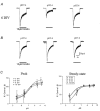
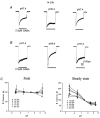

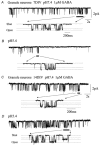

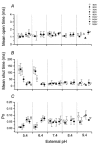
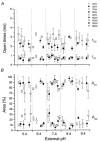

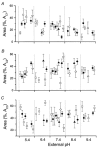
Similar articles
-
Whole-cell and single-channel currents activated by GABA and glycine in granule cells of the rat cerebellum.J Physiol. 1995 Jun 1;485 ( Pt 2)(Pt 2):419-35. doi: 10.1113/jphysiol.1995.sp020739. J Physiol. 1995. PMID: 7545231 Free PMC article.
-
Interaction of H+ and Zn2+ on recombinant and native rat neuronal GABAA receptors.J Physiol. 1998 Mar 15;507 ( Pt 3)(Pt 3):639-52. doi: 10.1111/j.1469-7793.1998.639bs.x. J Physiol. 1998. PMID: 9508826 Free PMC article.
-
Single-channel properties of neuronal GABAA receptors from mice lacking the 2 subunit.J Physiol. 2000 Aug 15;527 Pt 1(Pt 1):11-31. doi: 10.1111/j.1469-7793.2000.t01-1-00011.x. J Physiol. 2000. PMID: 10944167 Free PMC article.
-
Modulation of GABAA receptors in cerebellar granule neurons by ethanol: a review of genetic and electrophysiological studies.Alcohol. 2007 May;41(3):187-99. doi: 10.1016/j.alcohol.2007.04.004. Epub 2007 May 23. Alcohol. 2007. PMID: 17521847 Free PMC article. Review.
-
α6-Containing GABAA Receptors: Functional Roles and Therapeutic Potentials.Pharmacol Rev. 2022 Jan;74(1):238-270. doi: 10.1124/pharmrev.121.000293. Pharmacol Rev. 2022. PMID: 35017178 Review.
Cited by
-
Modulation of GABA(A) receptors by hydrogen ions reveals synaptic GABA transient and a crucial role of the desensitization process.J Neurosci. 2003 Sep 3;23(22):7981-92. doi: 10.1523/JNEUROSCI.23-22-07981.2003. J Neurosci. 2003. PMID: 12954859 Free PMC article.
-
Distinct activities of GABA agonists at synaptic- and extrasynaptic-type GABAA receptors.J Physiol. 2010 Apr 15;588(Pt 8):1251-68. doi: 10.1113/jphysiol.2009.182444. Epub 2010 Feb 22. J Physiol. 2010. PMID: 20176630 Free PMC article.
-
Extracellular proton modulates GABAergic synaptic transmission in rat hippocampal CA3 neurons.Brain Res. 2007 May 11;1145:213-20. doi: 10.1016/j.brainres.2007.01.121. Epub 2007 Feb 3. Brain Res. 2007. PMID: 17321506 Free PMC article.
-
Mechanisms of H+ modulation of glycinergic response in rat sacral dorsal commissural neurons.J Physiol. 2003 Oct 1;552(Pt 1):73-87. doi: 10.1113/jphysiol.2003.047324. Epub 2003 Jul 10. J Physiol. 2003. PMID: 12855675 Free PMC article.
-
Acid-sensitive ion channels and receptors.Handb Exp Pharmacol. 2009;(194):283-332. doi: 10.1007/978-3-540-79090-7_9. Handb Exp Pharmacol. 2009. PMID: 19655111 Free PMC article. Review.
References
-
- Angelotti TP, Tan F, Chahine KG, Macdonald RL. Molecular and electrophysiological characterization of an allelic variant of the rat α6 GABAA receptor subunit. Molecular Brain Research. 1992;16:173–178. - PubMed
Publication types
MeSH terms
Substances
LinkOut - more resources
Full Text Sources

